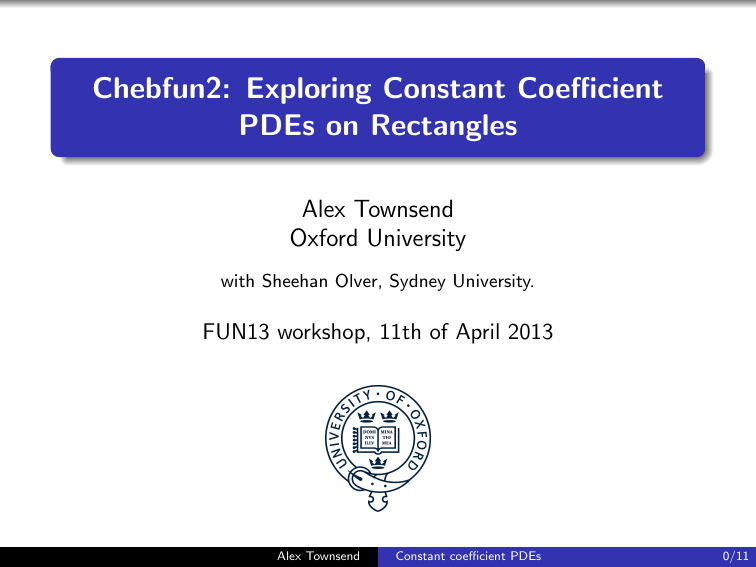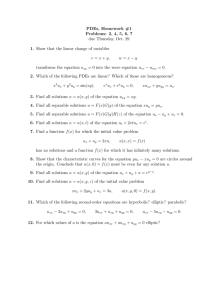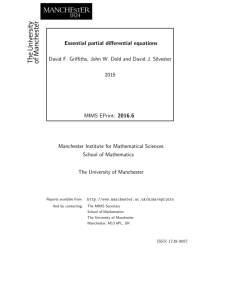Chebfun2: Exploring Constant Coefficient PDEs on Rectangles Alex Townsend Oxford University
advertisement

. . . . .. . Chebfun2: Exploring Constant Coefficient PDEs on Rectangles Alex Townsend Oxford University with Sheehan Olver, Sydney University. FUN13 workshop, 11th of April 2013 Alex Townsend Constant coefficient PDEs 0/11 . A simplified history of the Chebfun project . . Piecewise smooth (2010) . . . Endpoint singularities (2010*) Blow up functions (2011) Reducing regularity . Chebfun . (2004) . . Nonlinear ODEs (2012) Linear ODEs (2008) Chebgui (2011*) Ordinary differential equations . . . Piecewise smooth . Arbitrary domains Chebfun2 (2013) . . Linear PDEs . Nonlinear PDEs Two dimensions Alex Townsend Constant coefficient PDEs 1/11 . Chebop and Chebop2: Overall workflow L = chebop(@(x,u) diff(u,2)-x.*u, [-30 30]); L.lbc = 1; L.rbc = 0; u = L \ 0; . Convert handle. into discretisation instructions . Construct discretisation A ∈ Rn×n . Impose bcs and solve Ãx = b % Airy eqn % bcs % u = chebfun . Converged to the solution? .yes . Construct a chebfun .no, increase n [Driscoll, Bornemann, & Trefethen, 2008], [Birkisson & Driscoll, 2012] Alex Townsend Constant coefficient PDEs 2/11 . Chebop and Chebop2: Overall workflow L = chebop(@(x,u) diff(u,2)-x.*u, [-30 30]); L.lbc = 1; L.rbc = 0; u = L \ 0; . Convert handle. into discretisation instructions . Construct discretisation A ∈ Rn×n . Impose bcs and solve Ãx = b % Airy eqn % bcs % u = chebfun . Converged to the solution? .yes . Construct a chebfun .no, increase n [Driscoll, Bornemann, & Trefethen, 2008], [Birkisson & Driscoll, 2012] L = chebop2(@(u) diffx(u,2)+diffy(u,2)+100*u); L.lbc = 1; L.rbc = 1; L.ubc = 1; L.dbc = 1; u = L \ 0; . Convert handle. into discretisation instructions . . Impose bcs and solve matrix equation Construct a m by n generalised Sylvester matrix equation . % Helmholtz % bcs % u = chebfun2 Converged to the solution? .yes . Construct a chebfun2 .no, increase m or n or both Alex Townsend Constant coefficient PDEs 2/11 . The numerical rank of a matrix, function, and operator For an m × n matrix, ∑ . Numerical Rank min(m,n) A= σj uj vjT ≈ j=1 .k. ∑ σj uj vjT , σk+1 < tol. j=1 For a function of two variables (this is what Chebfun2 uses), ! f (x, y ) = ∞ ∑ σj uj (y )vj (x) ≈ .k. ∑ j=1 σj uj (y )vj (x). j=1 For operators acting on functions of two variables, ! L= ∞ ∑ σj Lyj ⊗ Lxj j=1 ≈ .k. ∑ σj . Lyj ⊗.. Lxj . j=1 . Discretise by a 1D spectral method [Olver & T., 2013] . Alex Townsend Constant coefficient PDEs 3/11 . Determining the rank of a PDE operator Given a PDE with constant coefficients of the form, L= N N−j ∑ ∑ j=0 i=0 aij ∂ i+j , ∂ i x∂ j y We can rewrite this as L = D(y )T AD(x), .A. = (aij ) , . Find by AD, thanks A. Birkisson 0 ∂ /∂x 0 .. D(x) = . . ∂ N /∂x N Hence, if A = UΣV T is the truncated SVD of A then ( ) ( ) ( ) L = D(y )T UΣV T D(x) = D(y )T U Σ V T D(x) . This low rank representation for L tells us how to discretize and solve the PDE. . Alex Townsend Constant coefficient PDEs 4/11 . Examples Helmholtz is of rank 2, uxx + uyy + 100u = (uxx + 50u) + (uyy + 50u) . The SVD obtains the rank 2 expression, ( ) uxx + uyy + 100u = 100.009.. −0.009..uyy − 0.999..u (−0.009..uxx − 0.999..u) ( ) + 0.009.. 0.999..uyy − 0.009..u (0.009..uxx − 0.999..u) . . . Rank 1: . Rank 3: Almost everything else ODEs Trivial PDEs . Rank 2: Laplace Helmholtz Transport Heat Wave . . Alex Townsend The method of separation of variables is useful. Constant coefficient PDEs 5/11 . Construct a m by n generalised Sylvester matrix equation If the PDE is Lu = f , where L is of rank-k then we solve for X ∈ Rm×n in, k ∑ σj Aj XB . jT = F , Aj .∈ Rm×m , . Bj ∈ Rn×n . j=1 . solution’s coefficients ( . 1D spectral discretization of Lyj , Lxj . ) Aj = Alex Townsend Constant coefficient PDEs 6/11 . Matrix equation solvers Rank-1: A1 XB1T = F . Solve A1 Y = F , then B1 X T = Y T . Rank-2: A1 XB1T + A2 XB2T = F . Generalised Bartels–Stewart algorithm [Gardener, Laub, Amato, & Moler, 1992] Rank-k, k ≥ 3: Solve mn × mn system with ‘\’ in Matlab. 2 Time to solve matrix equation 10 O(m2 n2 ) O(m3 + n3 ) Solve time 0 10 O(mn) −2 10 k=1 k=2 k≥3 −4 10 500 Alex Townsend 1000 m&n 1500 2000 Constant coefficient PDEs 7/11 . Have we converged? (simplified version) Increase m and n until the tail of the solution’s Chebyshev coefficients is near/below machine precision, and then truncate. Always 2j + 1−→ ←−−−−−−− Truncated coefficients These coefficients can then be used by Chebfun2 to construct a low rank function approximation [T. & Trefethen, 2013]. Alex Townsend Constant coefficient PDEs 8/11 . Overview and recap L = chebop2(@(u) diffx(u,2)+diffy(u,2)+100*u); L.lbc = 1; L.rbc = 1; L.ubc = 1; L.dbc = 1; u = L \ 0; . Convert handle. into discretisation instructions . . Impose bcs and solve matrix equation Construct a m by n generalised Sylvester matrix equation . % Helmholtz % bcs % u = chebfun2 Converged to the solution? .yes . Construct a chebfun2 .no, increase m or n or both Alex Townsend Constant coefficient PDEs 9/11 . Demo DEMO Alex Townsend Constant coefficient PDEs 10/11 . Future Work I would like to be able to do “vector-valued PDEs” such as Stokes equation: For Ω = [−1, 1] × [−1, 1], ∫ 1 ∫ −∇2~u + ∇p = ~f in Ω, ∇ · ~u = 0 in Ω, ~u = 0 on ∂Ω, 1 p(x, y )dxdy = 0 −1 in Ω. −1 Aiming for the following Chebfun2 syntax: N = chebop2v(@(u,p) [-lap(u) + grad(p); div(u)]); N.lbc = 0; N.rbc = 0; N.ubc = 0; N.dbc = 0; N.bc = @(u,p) sum2(p); uu = N \ [f;0]; Alex Townsend Constant coefficient PDEs 11/11 . References [Birkisson & Driscoll, 2012] Automatic Fréchet differentiation for the numerical solution of boundary-value problems, (ACM Trans. Math. Softw., 2012). [Driscoll, Bornemann, & Trefethen, 2008] The chebop system for automatic solution of differential equations (BIT Numer. Math., 2008). [Gardener, Laub, Amato, & Moler, 1992] Solution of the Sylvester matrix equation AXB T + CXD T = E , (ACM Trans. Math. Softw., 1992). [Olver & T., 2013] A fast and well-conditioned spectral method, (to appear in SIAM Review, 2013). [T. & Trefethen, 2013] An extension of Chebfun to two dimensions, (submitted, 2013). Alex Townsend Constant coefficient PDEs 12/11



